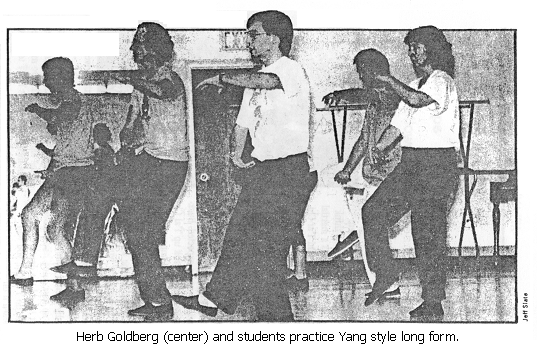[Published in CREATIVE LOAFING on September 19, 1987.]
Yin, yang
T'ai chi: An ancient dance for modern man
By John D. Thomas
Sports Editor
|
A Taoist priest dances methodically in the snow-covered mountains, redistributing yin and yang, oblivious to conflicts in the Persian Gulf or fiscal dealings on Wall Street.
His t'ai chi exercises restore balance to both mind and body. He
is an active paradox, at once elated and subdued, active and passive, in motion and at rest.
T'ai chi ch'uan is a centuries-old exercise and self-defense embodying the Chinese philosophical principle of the "supreme ultimate" in which opposites are balanced: yin with yang, firm with soft, power with passivity.
|
 |
It is a complete exercise, neglecting neither mind nor body. One could describe it as new age,
low-impact aerobics, akin to swimming on dry land. T'ai chi, like yoga, emphasizes calmness, stretching and inner unity.
It is, however, more physical, coordinating the continuous movement of arms, waist, legs, feet and mind.
T'ai chi stresses balance, timing, relaxed energy, breathing and mental concentration.
It can be done by anyone, regardless of body size or type, age, sex or ability.
Not a Buckhead aerobics class
Herb Goldberg teaches t'ai chi at various locations in the city. He has spread the art for many years, teaching in both Canada and
the United States. A sort of new age Renaissance man, Goldberg holds degrees
in physical and health education and applied social science and psychology.
Goldberg's popular classes are an eye-opening experience. When I arrived, students were casually stretching and conversing.
A variety of physiques were represented: short and stout, tall and lean and everything in between.
Goldberg soon arrived and separated the students into three groups -- another beginner and myself, several intermediate students and the advanced students.
The room instantly took on a subdued, serious air. Icons of the stereotypical Buckhead aerobics class
-- such as the ubiquitous blaring boom box, aggressive 105-pound instructors and competitive cellulite-conscious types were noticeably absent.
The intermediates were learning what the advanced students were perfecting, the
Yang-style long form. The form can be likened to a singular ballet of ebb and flow, of direction and
redirection, smooth but deliberate.
Learning to walk
When one begins t'ai chi, like an infant, one must first learn to walk.
This process is more taxing, both physically and mentally, than one might
think. The exercise begins with knees slightly bent, feet shoulder-length apart and weight distributed equally.
Weight is shifted to one side and the body follows.
My leg muscles burned after only minutes of practice, and I gained immediate respect for the other students who were involved in the more advanced aspects of t'ai chi, knowing that their muscles were conditioned and used to the strain.
Goldberg likens the air of his classes to "a one-room school house." He instructed me first, but later had an advanced student take over while he led the others.
While I continued my walking exercises, Goldberg allowed his group to perform, stepping in when conflicts arose.
As the class continued I was able to ask questions of the other students.
One aspect I was particularly fascinated with was the calmness of the discipline, the idea of trying to achieve a harmony with the universal yin-yang principles.
One woman who has been an active practitioner for many years said her t'ai chi exercises
made her feel good, and that this physical catharsis was the backbone of her desire to continue the practice.
With age comes mastery
Perhaps the one recurrent theme of my discussions with the students was that of age.
T'ai chi is a soft art, and stresses redirection and the deflection of incoming force, while karate arid other martial arts are hard, stressing a show of strength and challenging force with greater force.
The former is an art that ages well, while the force used in the harder martial arts is physically self-destructive.
Thus, in the long run, the t'ai chi master should bend, while the karate master breaks.
Even with the flexibility and added strength that are gained in t'ai chi, Goldberg says his discipline's cardiovascular benefits are minimal compared to either running or swimming.
The attraction of t'ai chi lies in the fact that it is not merely physical exercise.
The discipline has a profound effect on the whole person, and all aspects of his or her life.
One woman I spoke with was a chess master, and said that after beginning t'ai chi classes her concentration increased and her performance in match situations improved tremendously.
"T'ai chi helps in other areas of your life," says Goldberg. "It helps you to be more aware, teaching you more than just how to move your arms."
At the end of the class the form is practiced by all who can participate. Goldberg sees the form as "calm and fluid, very liquid."
Balance and breathing were stressed as the class moved both separately and together.
Finally, Goldberg and a student gave a demonstration of push hands, the martial aspect of
t'ai chi. The two men touched hands and began to move as a single being.
As one would inject yang energy, the other would counter with yin, yielding to the force.
T'ai chi did not look as intimidating as other martial arts I had seen, but Goldberg defended his art by saying that which is the softest
and most yielding has the potential to come back around with immense strength and yang energy.
To quote an ancient t'ai chi phrase, "four ounces of energy are able to deflect the momentum
of 1,000 pounds."
Back
